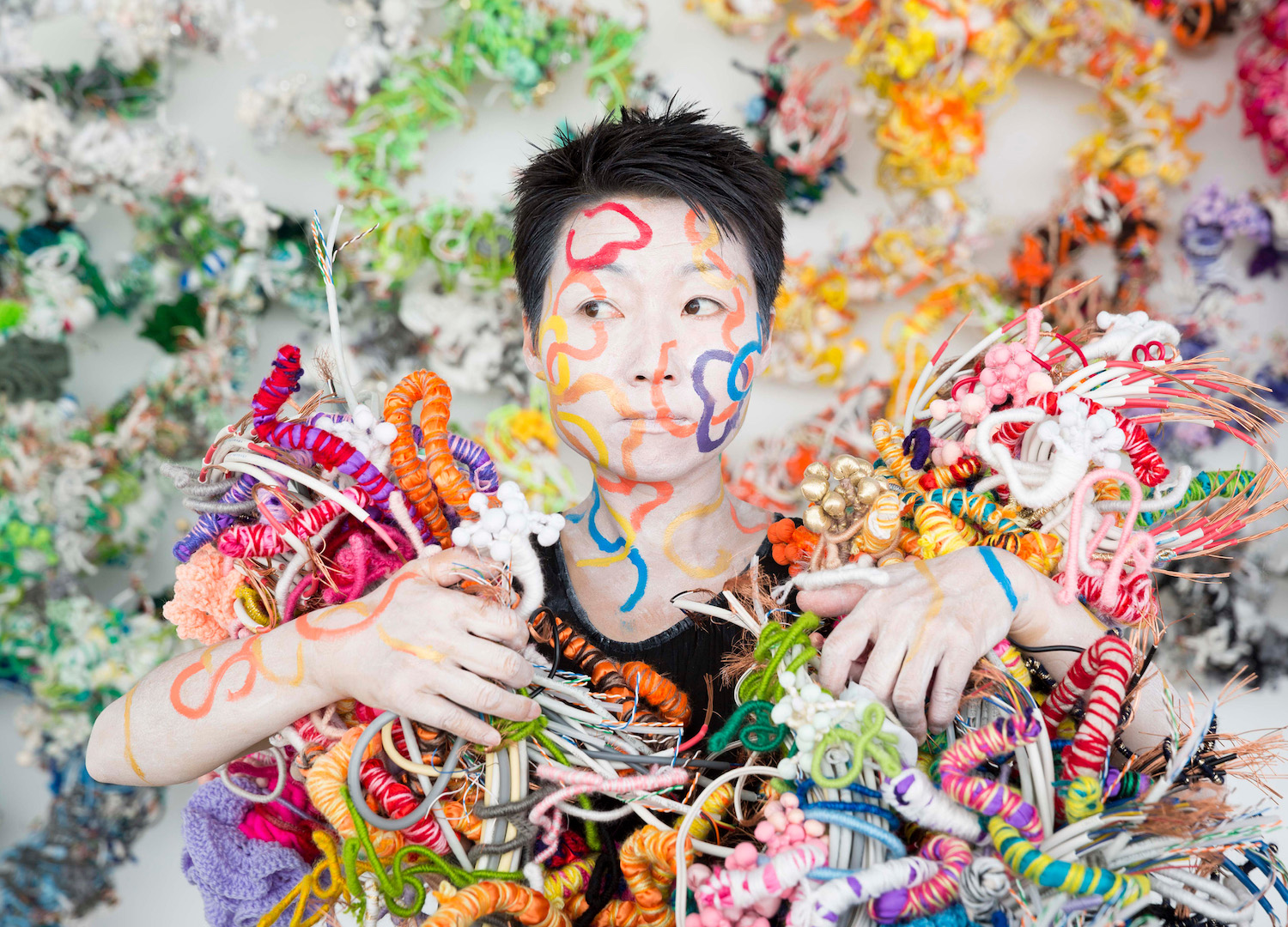
Art with Heart: Over the Rainbow with Hiromi Tango
images SUPPLIED above HEALING CHROMOSOMES BY HIROMI TANGO, 2017. PHOTO BY SIMON HEWSON.
A powerful force for change, art can make a deep and moving impact on our hearts and minds. With so many talented creatives in Australia moving and shaking to make the world a better place – and because Earth without art is just ‘eh’ – we’ve introduced a new digital series called Art with Heart to showcase the superstars in our local art scenes.
For over a decade, Japanese-Australian interdisciplinary artist Hiromi Tango has walked the rainbow road, focusing on the interesting intersection between art and mental health. While collaborating with scientists, health professionals and research institutions, her work remains a joyous celebration of what it means to be human and the transformative power of getting lost in colour. She’s recently collaborated with contemporary dance company Dancenorth and Aussie band Hiatus Kaiyote to create Wayfinder which will premiere at Brisbane Festival next month. We caught up with Hiromi to learn more about her practice and discover whether rainbows can actually make us happy.
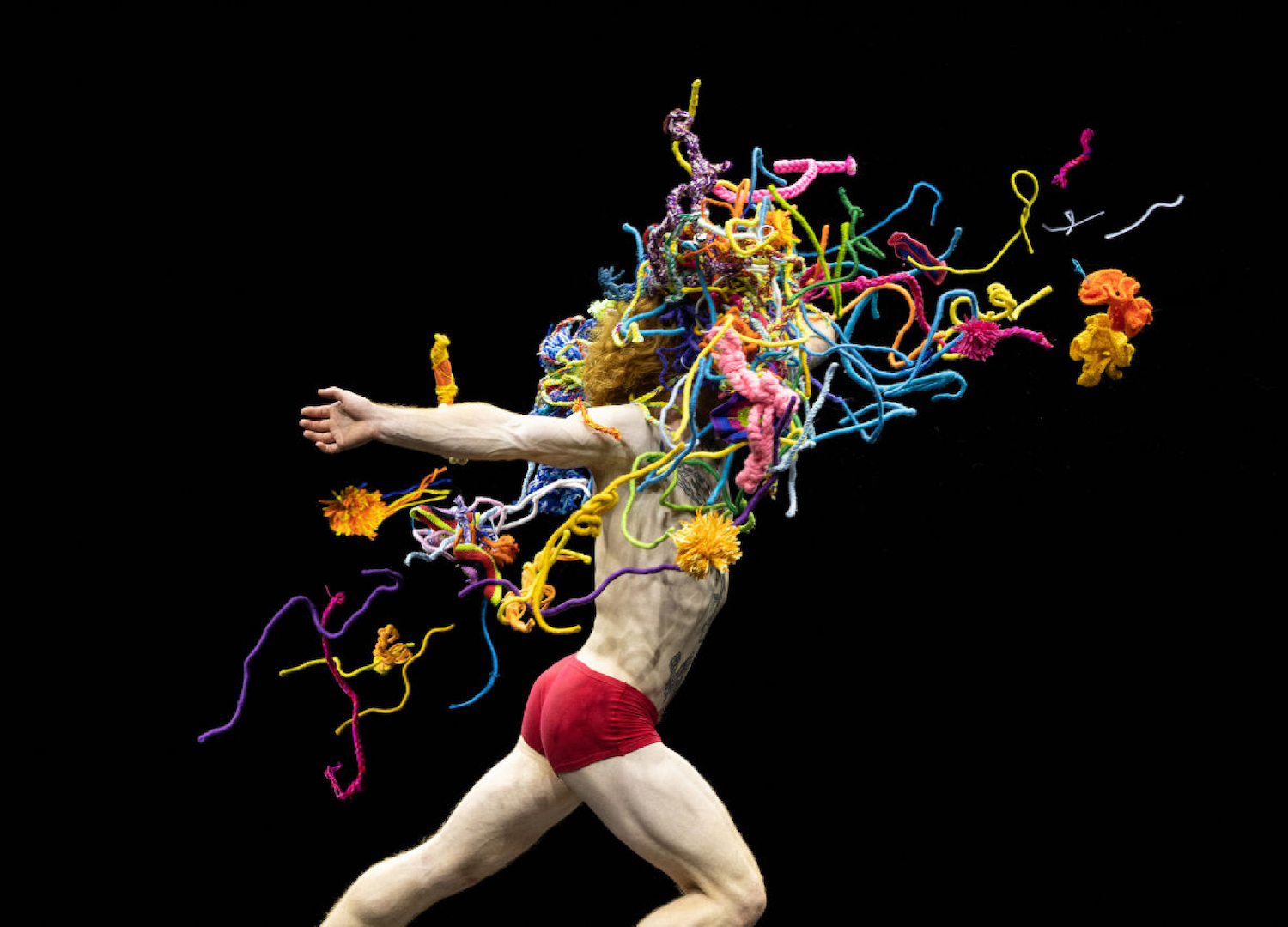
WAYFINDER BY DANCENORTH AUSTRALIA, 2021. PHOTO BY AMBER HAINES.
How did you come to be an artist?
I was always taught to recycle and be resourceful and be respectful to all materials and living beings. We always fixed everything to give it a long life, which I am grateful for. I do hope that I can teach those values to future generations.
I was always interested in art, and I have been surrounded and inspired by creative people since I was a child. My mother, aunty, grandmothers and cousins have all been very creative and innovative. Also living with my grandmother, and living in regional Japan, I had a strong foundation in traditional values and artforms.
In many ways, making things became my language. Where I grew up, women rarely spoke, but we expressed ourselves creatively. My goal to become an artist became very clear when I studied humanity and culture in arts at Japan Women’s University in Tokyo.
Tell us about your creative process…
Many times I will be reflecting on a thought or feeling and connections begin to flow even before I am aware of them. For example, over recent years when I have been unable to travel back to Japan to see my family, I have often found comfort in returning to materials and methods that are traditionally used in Japan.
With community engagement works, my creative process involves responding to an identified need or aspirational goal that is determined by the community and working with the community to develop and realise our shared artistic vision.
Working with Kyle Page, Amber Haines, Chloe Greaves, the Dancenorth team and community members on Wayfinder was a new and exhilarating process for me. It was such an incredible heart and soul expanding experience to respond to an artistic idea, and evolve it together with all the collaborators including community members through our respective languages of movement, sound and visual material.
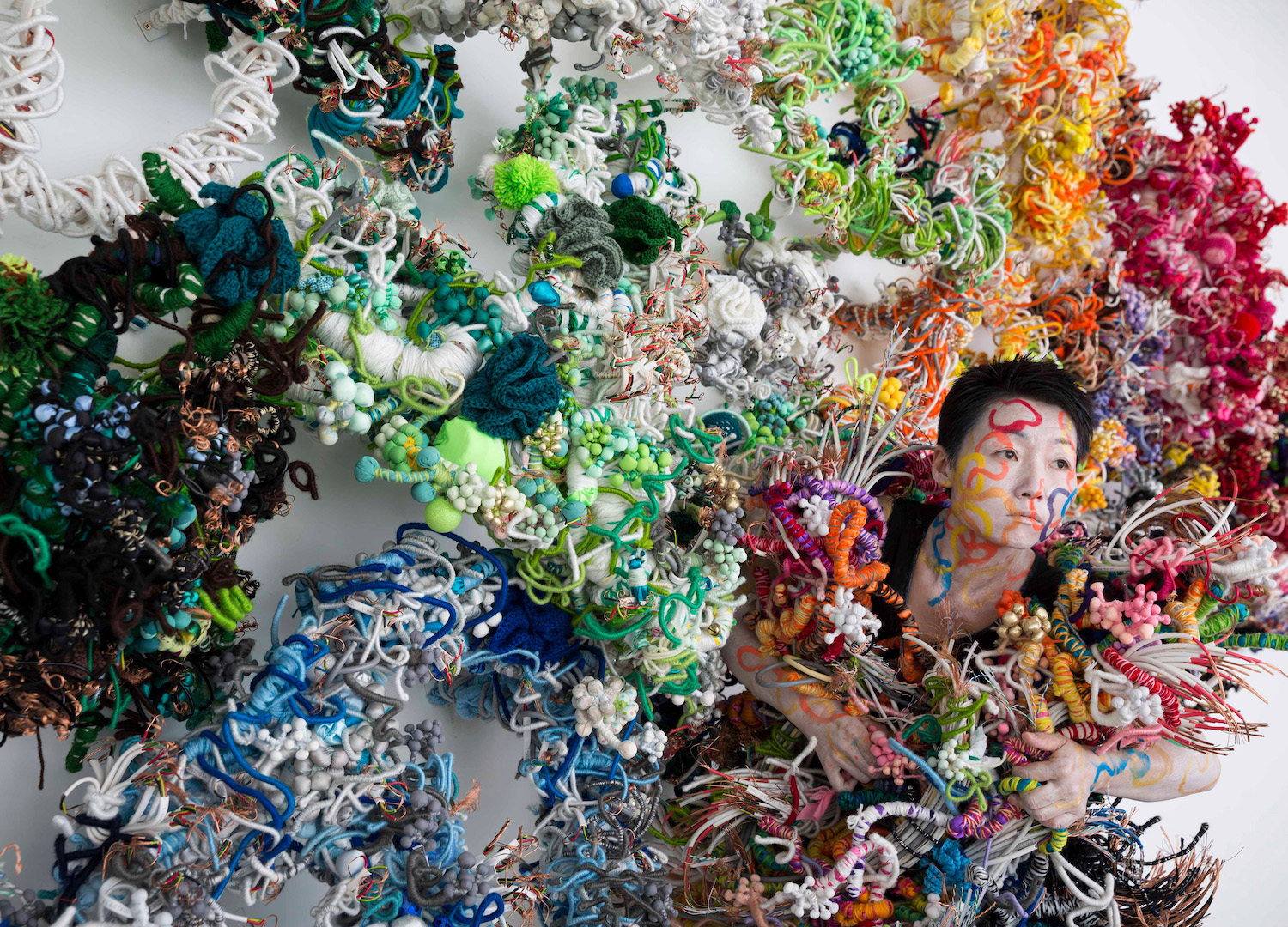
HEALING CHROMOSOMES BY HIROMI TANGO, 2017. PHOTO BY SIMON HEWSON.
Where do you find inspiration?
Inspiration finds me everywhere. The natural world: rainbows, the moon, flowers, the sea, seasonal cycles – all these things speak to resilience, regeneration, healing and hope. Materials and colours often spark inspiration. For example, I have created a number of works exploring my Japanese-Australian identity using my grandmother’s kimono, or other textiles and methods of making that reference traditional Japanese culture. I am also inspired by people and their stories. Over the last couple of years, I have thought a lot about the shared experiences of people who have been separated from their families overseas and their experiences, and how we can still be connected in spite of travel restrictions and time apart.
With Wayfinder, I was inspired by the idea of creating a counterpoint to the feelings of uncertainty and isolation that have become so prevalent through COVID. Rainbow themes have been very important to me through this time, and I wanted to find a way to translate the light and colour of rainbows into movement, in a way that also embodied the collective energy of the community.
Creating has always been a way for me to communicate, process thoughts and feelings, and help bring a sense of harmony and balance to a world that is often chaotic.
What motivates you to create?
Creating has always been a way for me to communicate, process thoughts and feelings, and help bring a sense of harmony and balance to a world that is often chaotic. I create because I need to for myself, but also because I feel a sense of urgency for others. Art-making is often a way for me to express my wish for humanity, as a way to help create a sense of hope and healing for everyone.
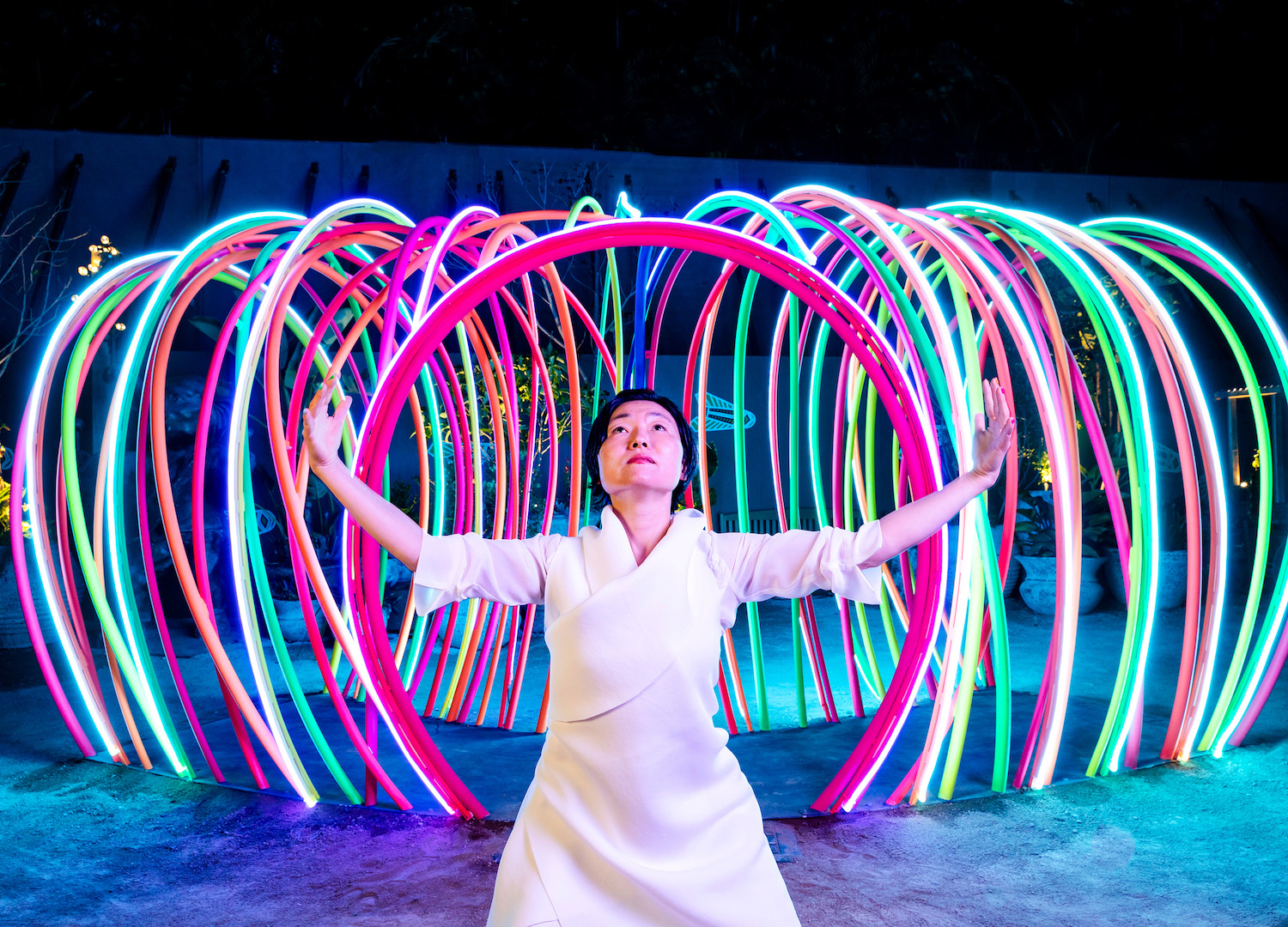
RAINBOW CIRCLES (HEALING CIRCLES) BY HIROMI TANGO, 2020. PHOTO BY JOE RUCKLI.
What delights you about installations and performance art?
During my studies in Japan, I became very interested in Noh theatre, and still reference a lot of this in my performative installations through slow, meditative movement and the use of costumes and masks. I am interested in creating experiences through art, where people are drawn into a moment, where they might slow down and connect deeply with a feeling or idea. For me, immersive installations and performing arts both allow people to suspend the outside world for just a little while. Dancer Sally Chance talks about creating and holding space – this is a very profound idea for me and one that I hope to achieve through my practice.
Working with the Dancenorth team has absolutely delighted me as it has drawn me into a completely different kind of performance energy. The exuberance of Wayfinder is spellbinding and I am in awe of how other artists interact with and interpret the visual world that I have created with the North Queensland community, visual design team (Chloe Greaves and Jeanette Hutchinson) and local artists.
I am interested in creating experiences through art, where people are drawn into a moment, where they might slow down and connect deeply with a feeling or idea.
Is there something you can’t live without in your studio?
Ironically, a sense of order. There are so many materials, so many works in progress, so many colours, textures and shapes. It could become overwhelming, but I actually work to create a sense of order and harmony through things like colour-categorising yarns, for example. This helps to create space for me where ideas can begin to take shape. It isn’t a thing so much as a sense of balance that brings together sources of inspiration with a clear space for thinking and tuning in to how I am feeling.
Why do you think art is important to society?
Think about how music permeates our lives: it is difficult to imagine so many aspects of day-to-day life without music. It is easy to recall examples of how a favourite song makes you feel, and there are many moments that are instantly recognisable because of the associated music.
In the busyness of everyday life, we often prioritise productivity over living well. As a result, we neglect our inner lives and our environment, and everything begins to suffer.
Art makes us slow down and reconnect in many ways. It asks questions that might make us think more deeply on an issue. It exposes issues in ways that make it difficult to ignore them. It might evoke a feeling that we have been too busy to notice.
On both an individual and societal level, art is essential to helping us reflect and become more conscious of ourselves, our actions and what is happening around us.
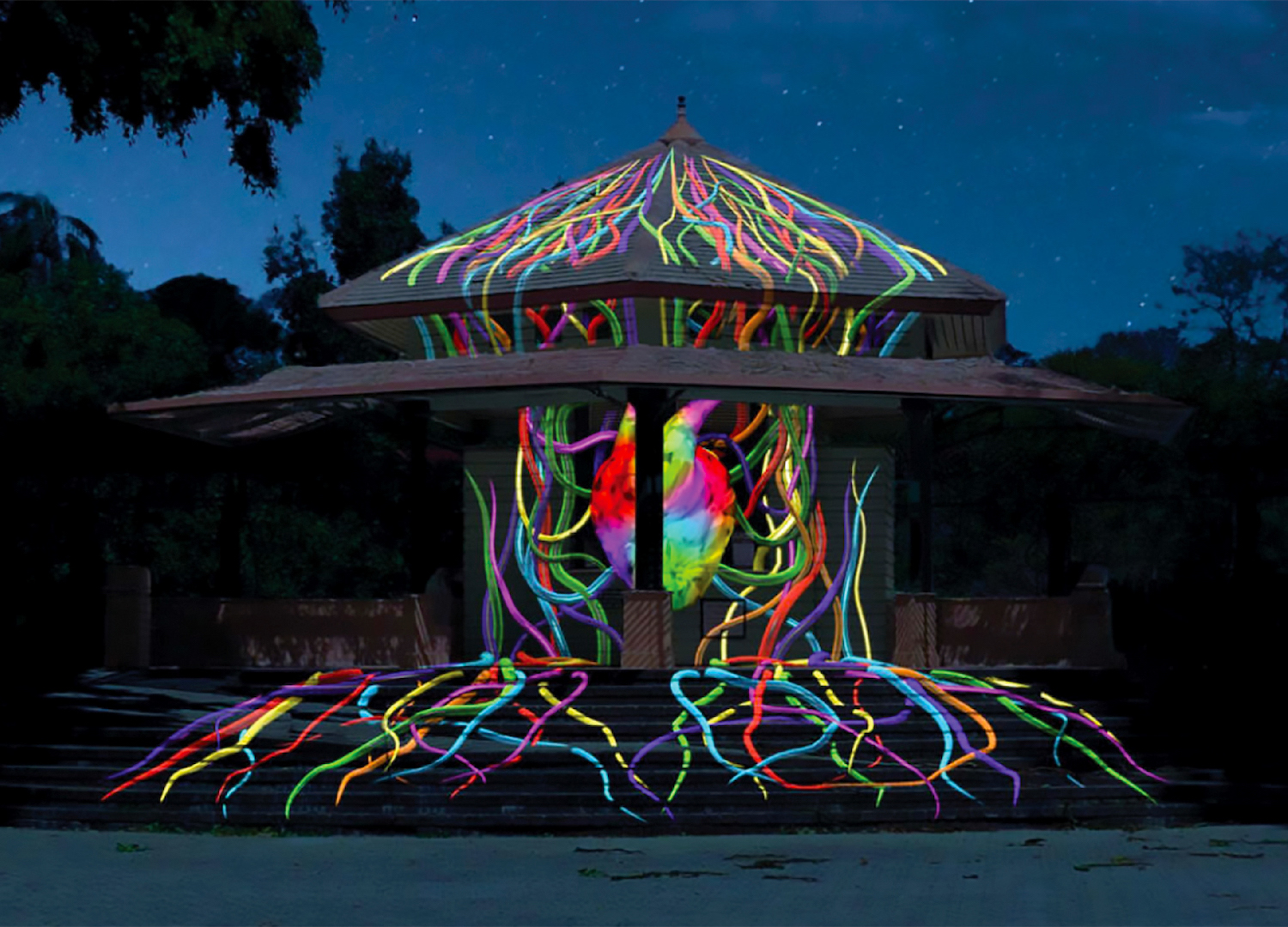
HEARTBEAT BY HIROMI TANGO, 2021. PHOTO BY HIROMI TANGO.
You work at the intersection of art and mental health issues. What are the possibilities of art for addressing some of our mental health issues, as you’ve discovered through your art?
My own journey with art and mental health began with research and experimentation around how meditative art-making practices might help to calm the anxiety and tendency to overthink that I have lived with throughout my life. About a decade ago, I read The Brain That Changes Itself by Dr Norman Doidge and was captivated by the idea of neuroplasticity and the potential for art to play a role in creating positive change in our actual neural circuitry. I knew that for myself, engaging in meditative art-making activities – such as colour-categorising materials, repetitive actions like wrapping and knitting, and working within a calm space – was beneficial to my mental health. I began to collaborate with neuroscience professionals to deepen my understanding of the relationship between art and mental health, and these collaborations have grown over many art and health projects with communities, including a current and ongoing collaboration with Dr Emma Burrows from the Florey Institute of Neuroscience and Mental Health.
Simply taking time through art engagement – where we can slow down and become aware of ourselves and our environment – allows us to process our experiences and feelings, and connect with others through shared experiences.
My layperson’s perspective of how art can help to address some of our mental health issues is that simply taking time through art engagement – where we can slow down and become aware of ourselves and our environment – allows us to process our experiences and feelings, and connect with others through shared experiences.
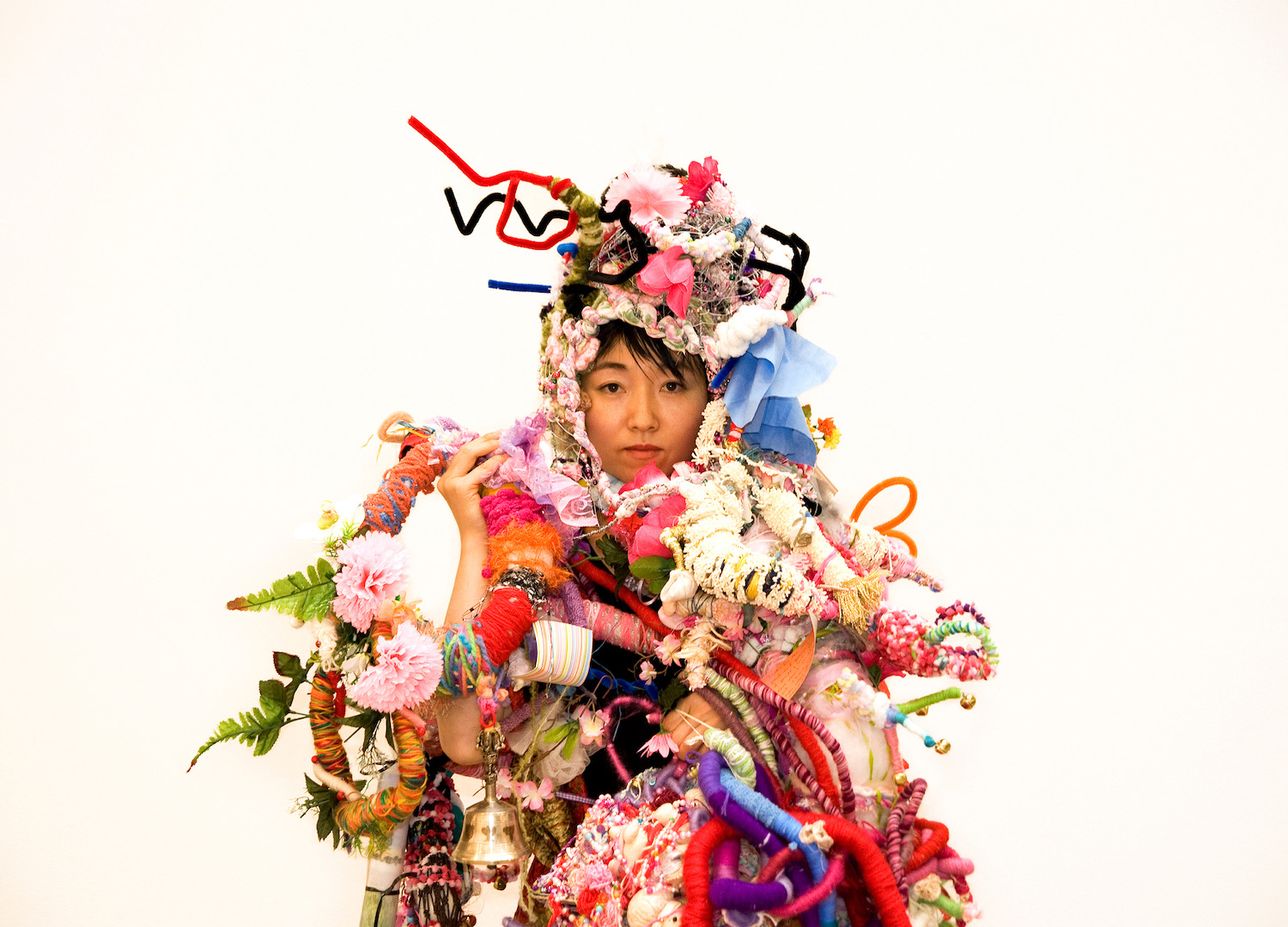
PISTIL – X CHROMOSOME BY HIROMI TANGO, 2012. PHOTO BY YUJI YUKISHIRO.
The meditative aspects of the art-making process itself can benefit our mental health by reducing anxiety as it makes us focus wholly on what we are doing, diverting us from negative thought patterns while we engage in something that evokes positive feelings. Whether you are making art or immersing yourself in an art experience, aspects of colour, movement, aroma, light and sound can all evoke positive feelings. I believe that Wayfinder is exactly that – a kind of way for the creators and makers to share their positive energy with the audience.
Thematically, art can inspire us to see the world around us differently. For example, we might take more time to appreciate all the ways that nature is resilient and be inspired to care for the environment that nourishes us. Or we might start to notice the brilliant colours in everyday life a bit more.
Some artworks might explore darker themes, helping people to acknowledge and process thoughts and feelings that they find hard to otherwise articulate. Sometimes we need to be given a means of entering into a vulnerable space where we can connect with uncomfortable or difficult feelings in order to acknowledge and process them. Have you ever had the experience of feeling better after listening to a sad piece of music? Visual art can be cathartic in the same way.
Finally, I am a huge believer in the power of bringing people together for collective experiences. Loneliness has become such an issue in contemporary life. For so many reasons – the dramatic shift to online interaction, less engagement with the local community due to work and time pressures, and for many living far away from extended family – we just don’t spend enough time together making things, sharing stories and feeling connected with others around us. Community-engaged art-making brings people into a shared space with a shared purpose, creating a framework for different kinds of social connections to flourish.

BRAINBOW MAGIC BY HIROMI TANGO, 2020. PHOTO BY JOE RUCKLI.
What could society do to better support artists?
It’s an interesting question. Over the last decade or so, there has been such a strong focus on building sustainable careers, as though it was only a question of artists needing to be paid for their time and materials. So much of what makes art compelling or important has been lost by focussing on the money question.
If we started from a place where it was agreed that art is important to everyone’s life, and it is understood that making impactful work involves research, experimentation, practice, risk-taking and making yourself very vulnerable, artists might feel better supported. I have recently worked on projects where the expectation was that we carry on without any consideration for the impact of COVID restrictions, illness, flooding and a range of personal circumstances, just to deliver a result on time and on budget. This has made me question what a sustainable practice means.
Working with the Dancenorth team on Wayfinder was an incredible experience because I felt so supported by everyone around me. At different times, we all faced challenges during the creative process. During the recent floods in Northern New South Wales where I live, I was feeling incredibly stressed about maintaining all my commitments to travel for work when my local community was suffering so much. Having the support of Kyle, Amber and the whole team to work flexibly – and knowing that they understood the impacts of flooding on their community all too well – made it possible for me to stay with the project and invest my whole self.
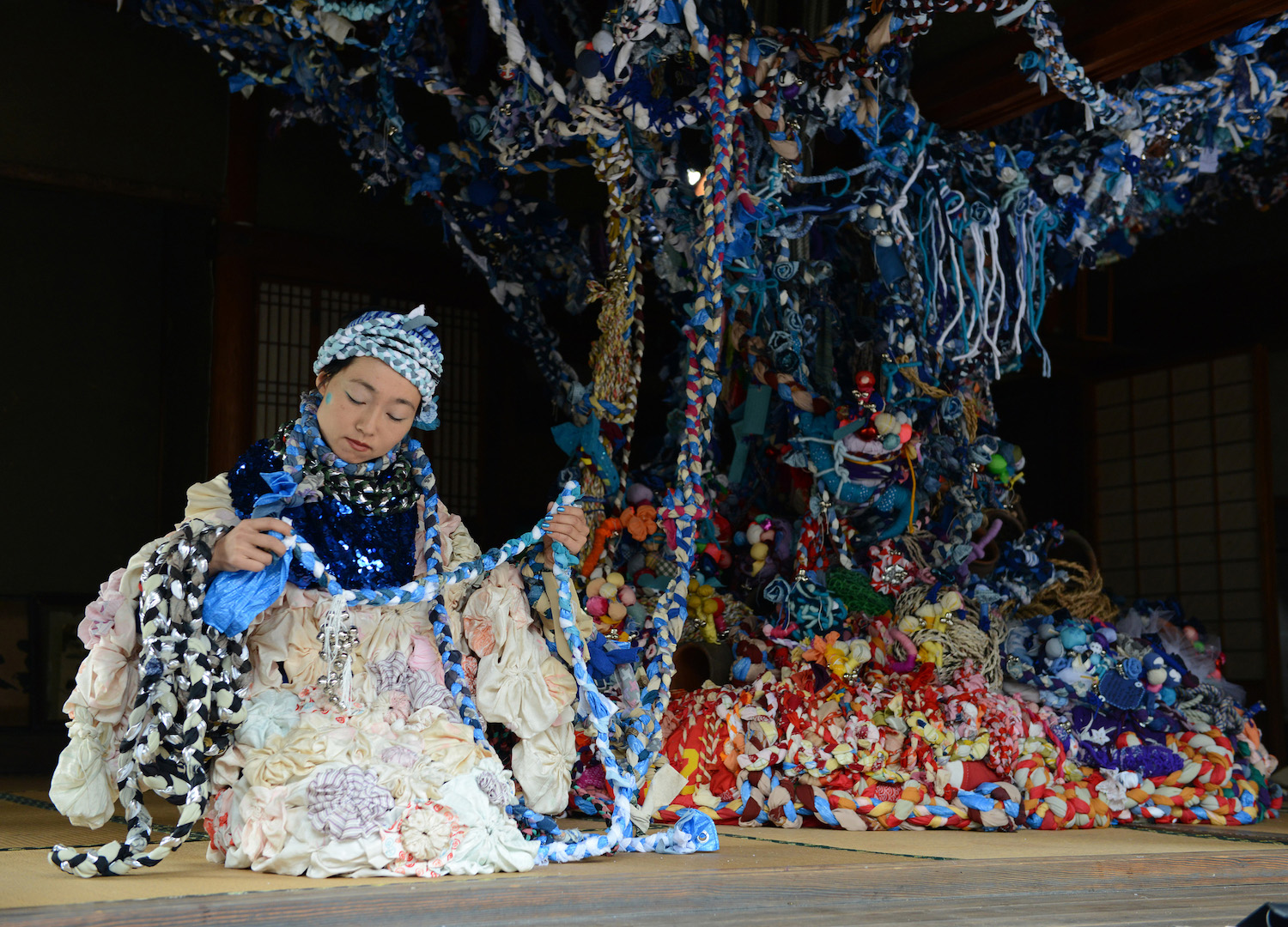
TRACES BLUE BY HIROMI TANGO, 2013. PHOTO BY CRAIG WALSH AND HIROMI TANGO.
What are you working on currently that excites you?
I am so looking forward to being part of Wayfinder during Brisbane Festival. Seeing everything come to life on stage and feeling the energy of several flood-affected communities connecting in such a positive way will be such an amazing experience. For me, this project began several years ago when I heard about the Townsville floods. I really wanted to do something for the community and visited for a talk and mini-workshop in May 2019. We had an opportunity to do a larger project together that was set to launch in 2020, just as COVID hit. While there were many delays and changes along the way as all our worlds were impacted by the pandemic, I was able to work with communities across North Queensland on a Lizard Tail project that used the lizard’s ability to separate itself from its tail when faced with danger as a metaphor for resilience and transformation. Through these workshops, I connected with Kyle, as well as community members who have been part of the Wayfinder creative journey.
I am also working toward a solo exhibition that continues my exploration of my Japanese-Australian identity. This is the culmination of a period of deep reflection over the last two-and-a-half years, where I have not been able to travel to Japan to see my parents, brother and extended family. There have been a number of deaths in my family during this time and art has become an important means of feeling connected to people and traditions.
Who do you think are your biggest artistic influences?
Yayoi Kusama. She has been very open about her struggles with mental health, and she has successfully navigated her identity and career as a dual citizen.
Craig Walsh (my husband) is also a huge inspiration. The projects that we have collaborated on, such as Home and FIVE provided opportunities to use our respective artistic practices to help communities transform their narratives. Craig has a really unique way of reflecting ordinary things in an extraordinary way that helps us see our world through a very different lens. I think I might have fallen in love with his art first, then him as a person.
What’s your favourite work of art?
Kusama’s Infinity Mirrored Room series. I love the expansiveness, the endless possibilities, the light and colour and immersion.
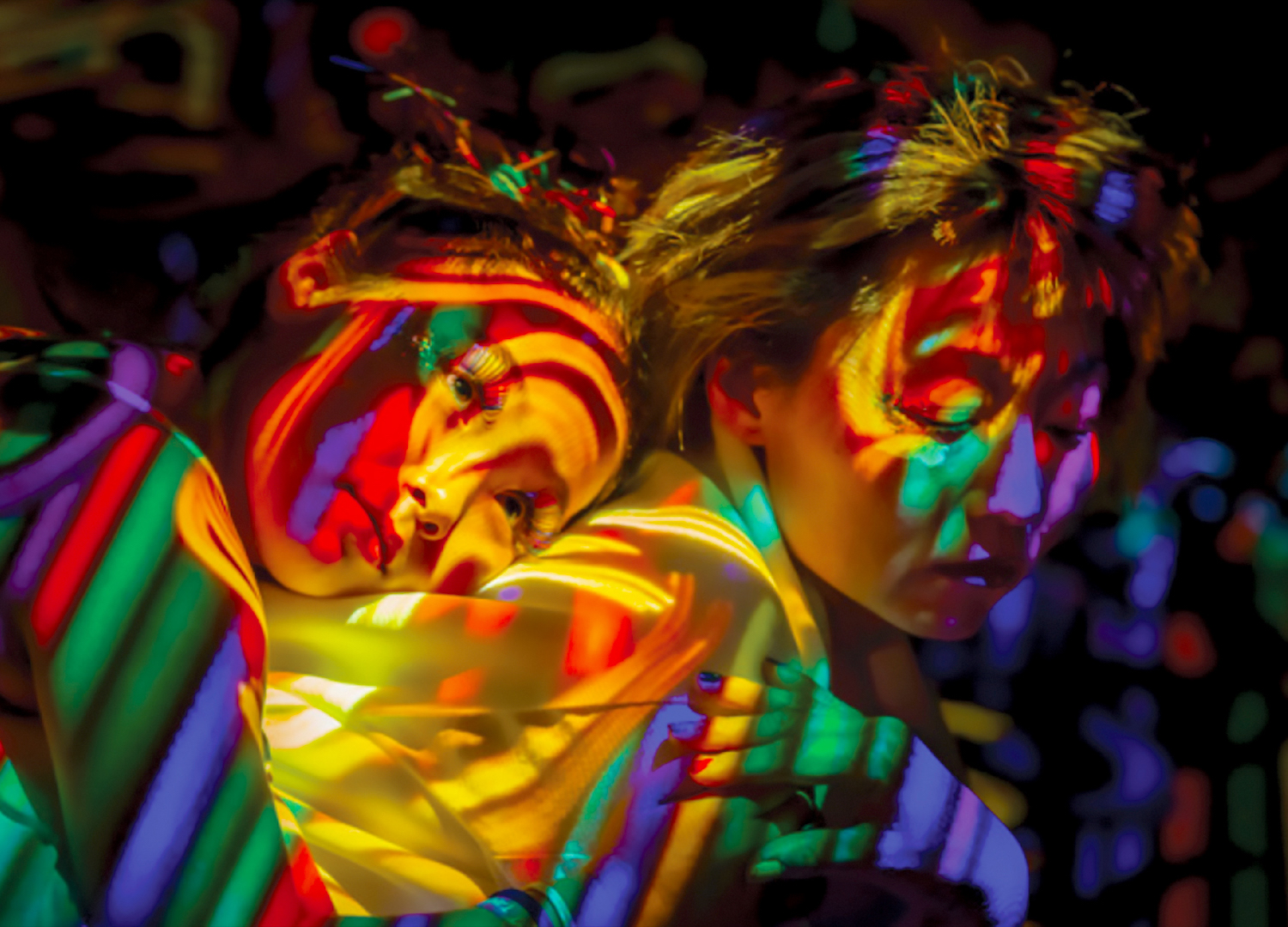
HIROMI HOTEL – BRAINFLOWER BY HIROMI TANGO, 2019. PHOTO BY STEVE MARDON.
What would be your dream project?
My dream is to create Hiromi Hotel as a permanent space. There have been many temporal installations where people have been invited to come inside, slow down, unburden their psyche and create even for just a little while. I would love it to become an actual hotel, where people could be cared for through art. One of my collaborators – consulting psychiatrist Dr Patricia Jungfer – talks about the origins of the word hotel in an article on the origins of Hiromi Hotel: “The word ‘hotel’ derives from the French ‘hôtel’; a hotel historically being a place that had frequent visitors and which provided care, rather than a place of accommodation. The word ‘hôtel’ shares the etymological root with the word ‘hospital’; a space which is dedicated to the art of healing.” Realising this as an actual hotel where people can check-in and stay is my dream.
My dream is to create Hiromi Hotel as a permanent space… where people could be cared for through art.
Has your practice changed over time?
If I look back to the works that I was creating early in my career, when I was a new migrant to Australia, there has been a significant shift from the very ephemeral and third-person (think post-it notes and inhabiting other people’s stories), to more autobiographical and permanent. There are a few layers to this change. I have learned to lean into my Japanese-Australian identity rather than trying to evade it. This is reflected in both choices and methods, and also feeling confident to apply my personal cultural lens to thematic explorations. I have also been experimenting with more permanent materials as my practice has moved away from temporal to permanent public art. This has enabled me to experiment with retaining the signature of handmade objects – whether my own or co-created with communities – in permanent forms such as the cast bronze sculpture at Brisbane’s Mount Coot-tha Botanic Gardens. I have also been experimenting with digital media and light as a way of creating light, colour and movement – both in my public and solo practice.

DR EMMA BURROWS AND HIROMI TANGO SITTING ATOP WHEEL, 2021.
And finally, can rainbows actually make us happy?
Absolutely! My collaborator Dr Emma Burrows talks about how rainbows capture our attention because they are rare – humans are drawn to them when they appear. They draw our attention to colour and light, things that are generally associated with a positive mindset. For me, they are a symbol of resilience because they appear after the storm – a powerful reminder that even during dark times we know the light will return. When I collaborated with Dr Emma Burrows to create Wheel, a human-sized hamster wheel, we set out to understand whether the joyful rainbow colours might have an impact on our motivation to exercise. We know that exercise is beneficial to our mood and we were curious about whether creating an immersive rainbow experience might just inspire more exercise. You can read more about the project here.
They are a symbol of resilience because they appear after the storm – a powerful reminder that even during dark times we know the light will return.
In Wayfinder, I hope that the rainbow colours contribute to the energy, joy and positivity of the work. When I look back at the project, and the energy and joy of the community members who gathered recycled materials to create the rainbow textiles, and think about how we have connected three wonderful, resilient, flood-affected communities (Townsville, Brisbane and Northern NSW) through this work, it absolutely makes me happy.


